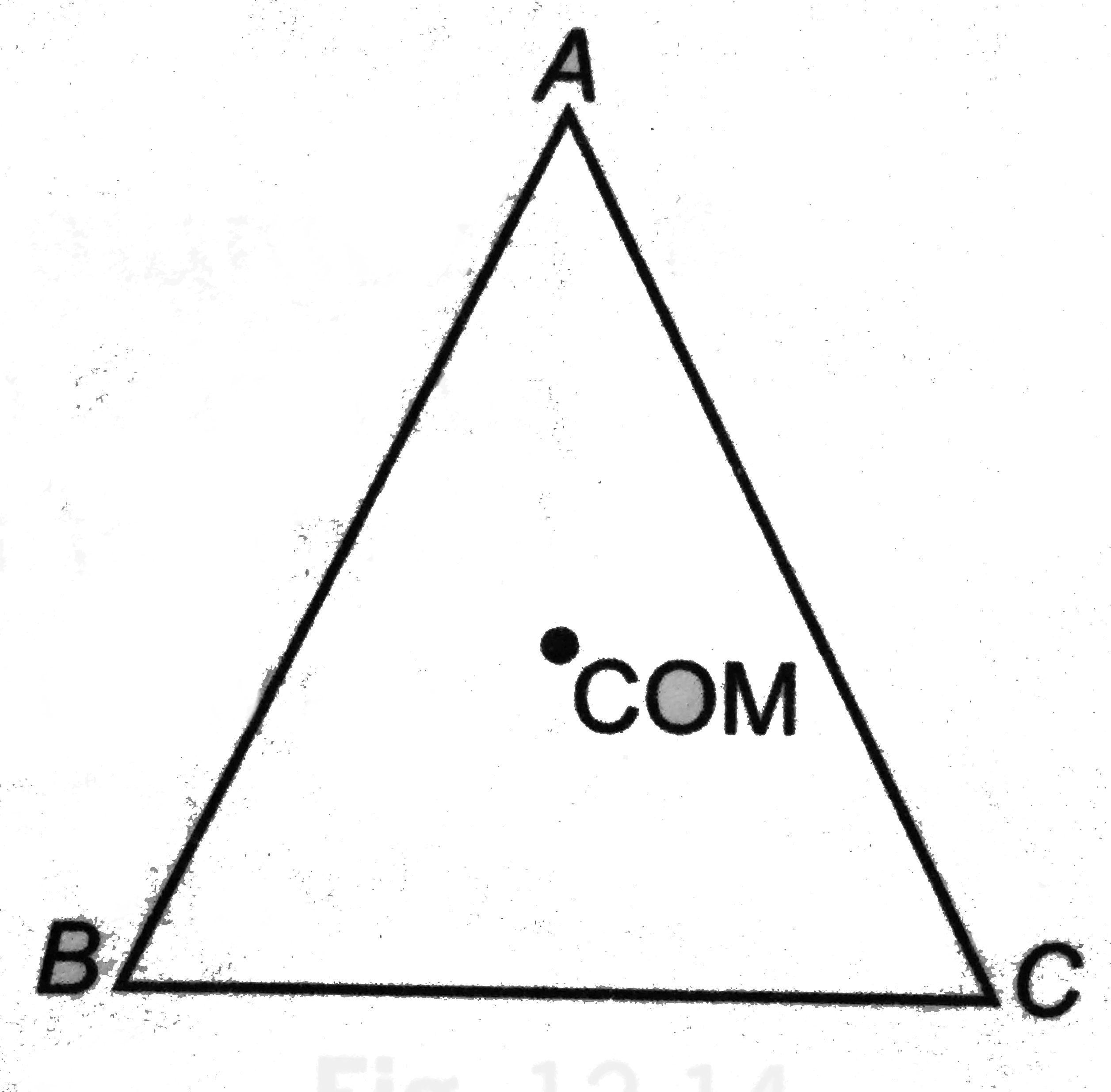Two point masses m1 and m2 are joined by a weightless rod of length r. Calculate the moment of inerrtia of the system about an axis passing through its centre of mass and perpendicular to the rod.
To calculate the moment of inertia of the system about an axis passing through its center of mass and perpendicular to the rod, we can follow these steps:
Step 1: Understand the System
We have two point masses m1 and m2 connected by a weightless rod of length r. We need to find the moment of inertia about the center of mass (CM) of the system.
Step 2: Find the Position of the Center of Mass
The position of the center of mass RCM can be calculated using the formula:
RCM=m1⋅0+m2⋅rm1+m2=m2⋅rm1+m2
Here, we assume m1 is at the origin (0) and m2 is at position r.
Step 3: Calculate Distances from the Center of Mass
The distances of the masses from the center of mass are given by:
- For mass m1:
R1=RCM=m2⋅rm1+m2
- For mass m2:
R2=r−RCM=r−m2⋅rm1+m2=m1⋅rm1+m2
Step 4: Calculate the Moment of Inertia
The moment of inertia ICM about the center of mass is given by:
ICM=m1R21+m2R22
Substituting the values of R1 and R2:
ICM=m1(m2⋅rm1+m2)2+m2(m1⋅rm1+m2)2
Step 5: Simplify the Expression
Now, we simplify:
ICM=m1⋅m22⋅r2(m1+m2)2+m2⋅m21⋅r2(m1+m2)2
Factoring out common terms:
ICM=r2(m1+m2)2(m1m22+m2m21)
This can be rewritten as:
ICM=m1m2m1+m2r2
Final Result
Thus, the moment of inertia of the system about the center of mass is:
ICM=μr2
where μ=m1m2m1+m2 is the reduced mass of the two masses.
---
We have two point masses m1 and m2 connected by a weightless rod of length r. We need to find the moment of inertia about the center of mass (CM) of the system.
The position of the center of mass RCM can be calculated using the formula:
RCM=m1⋅0+m2⋅rm1+m2=m2⋅rm1+m2
Here, we assume m1 is at the origin (0) and m2 is at position r.
The distances of the masses from the center of mass are given by:
- For mass m1:
R1=RCM=m2⋅rm1+m2
- For mass m2:
R2=r−RCM=r−m2⋅rm1+m2=m1⋅rm1+m2
The moment of inertia ICM about the center of mass is given by:
ICM=m1R21+m2R22
Substituting the values of R1 and R2:
ICM=m1(m2⋅rm1+m2)2+m2(m1⋅rm1+m2)2
Now, we simplify:
ICM=m1⋅m22⋅r2(m1+m2)2+m2⋅m21⋅r2(m1+m2)2
Factoring out common terms:
ICM=r2(m1+m2)2(m1m22+m2m21)
This can be rewritten as:
ICM=m1m2m1+m2r2
Thus, the moment of inertia of the system about the center of mass is:
ICM=μr2
where μ=m1m2m1+m2 is the reduced mass of the two masses.
Topper's Solved these Questions
- ROTATIONAL MECHANICSBOOK - DC PANDEY ENGLISHCHAPTER - ROTATIONAL MECHANICSEXERCISE - Level 2 Single Correct
26 Videos
- ROTATIONAL MECHANICSBOOK - DC PANDEY ENGLISHCHAPTER - ROTATIONAL MECHANICSEXERCISE - Level 2 Multiple Correct
36 Videos
- ROTATIONAL MECHANICSBOOK - DC PANDEY ENGLISHCHAPTER - ROTATIONAL MECHANICSEXERCISE - Level 1 Objective
30 Videos
- ROTATIONBOOK - DC PANDEY ENGLISHCHAPTER - ROTATIONEXERCISE - (C) Chapter Exercises
39 Videos
- ROTATIONAL MOTIONBOOK - DC PANDEY ENGLISHCHAPTER - ROTATIONAL MOTIONEXERCISE - Integer Type Questions
17 Videos
Similar Questions
A diatomic molecule is formed by two atoms which may be treated as mass points m1 and m2 joined by a massless rod of length r. Then the moment of inertia of molecule about an axis passing through centre of mass and perpendicular to the rod is:
View SolutionTwo spheres each of mass M and radius R/2 are connected with a massless rod of length R. Find the moment of inertia of the system about an axis passing through the centre of one of the sphere and perpendicular to the rod
View Solution
Knowledge Check
Two masses each of mass M are attached to the end of a rigid massless rod of length L. The moment of interia of the system about an axis passing centre of mass and perpendicular to its length is.
AML2/4BML2/2CML2D2ML2
Two masses m1andm2 are placed at a distance r from each other. Find out the moment of inertia of system about an axis passing through their centre of mass.
View Solution
Three rods each of mass m and length l are joined together to form an equilateral triangle as shown in figure. Find the moment of inertial of the system about an axis passing through its centre of mass and perpendicular to the plane of the particle.
View Solution
Three rods each of mass m and length l are joined together to form an equilateral triangle as shown in figure. Find the moment of inertial of the system about an axis passing through its centre of mass and perpendicular to the plane of the particle.
View SolutionTwo point masses m and 3m are placed at distance r. The moment of inertia of the system about an axis passing through the centre of mass of system and perpendicular to the joining the point masses is
View SolutionMoment of inertia of a ring of mass M and radius R about an axis passing through the centre and perpendicular to the plane is
View SolutionTwo particles of masses m1andm2 are joined by a light rigid rod of length r. The system rotates at an angular speed ω about an axis through the centre of mass of the system and perpendicular to the rod. Show that the angular momentum of the system is L=μr2ω where μ is the reduced mass of the system defined as μ=m1m2m1+m2
View SolutionThe mass of a unifprm rod is 0.4 kg and its length is 2 m. .Calculate the radius of gyration of the rod about an axis passing through its centre of mass and perpendicular to its length ?
View Solution
